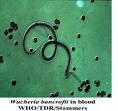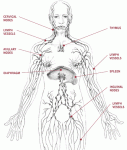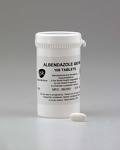Lymphatic What?? Haiti and a Neglected Disease
 HIV/AIDS, Malaria, and TB are the unholy Trinity of illness in the developing world. But there are a number of less widely known diseases, which while not fatal, cause a great deal of sickness, suffering, and disability. One of them is Lymphatic Filariasis, also known as Elephantiasis. But what is it? LF is a disease that is transmitted by mosquitoes that bite infected humans and pick up microfilariae – thread like parasitic worms. Below is a picture.
HIV/AIDS, Malaria, and TB are the unholy Trinity of illness in the developing world. But there are a number of less widely known diseases, which while not fatal, cause a great deal of sickness, suffering, and disability. One of them is Lymphatic Filariasis, also known as Elephantiasis. But what is it? LF is a disease that is transmitted by mosquitoes that bite infected humans and pick up microfilariae – thread like parasitic worms. Below is a picture.

Inside the mosquito, the microfilariae start to develop and become infective. The process takes one to three weeks. The larvae migrate up to the mosquitoes' biting mouth-parts, and enter the punctured skin when the mosquito takes its next blood meal, infects another human being starting the cycle all over again.
 Why is it called lymphatic? The worms lodge in the lymphatic system which is the network of nodes and vessels that maintain fluid balance between the tissues and blood and keep the immune system running properly. The filariae live for about 4-6 years, and here is the problem, they produce millions and millions of larvae which circulate in the blood. This causes the immne system to go haywire and painful, disfiguring swelling results in the limbs can result – most commonly in the extremities. In both men and women, swelling can occur in the gentials, which can cause the person to be stigmatized.
Why is it called lymphatic? The worms lodge in the lymphatic system which is the network of nodes and vessels that maintain fluid balance between the tissues and blood and keep the immune system running properly. The filariae live for about 4-6 years, and here is the problem, they produce millions and millions of larvae which circulate in the blood. This causes the immne system to go haywire and painful, disfiguring swelling results in the limbs can result – most commonly in the extremities. In both men and women, swelling can occur in the gentials, which can cause the person to be stigmatized.
It can be aymptomatic and indeed many will never develop outward symptoms - but there still could be hidden damage to the lymphatic system and the kidneys. It can be acute form which can cause pain, inflammation, and nausea. It can also be chronic which produces the characteristic long term suffering. According to the World Health Organization (WHO), over a billion people in 80 countries are at risk for Lymphatic Filariasis. Over 120 million have already been affected by it, and of these, over 40 million of them are seriously incapacitated and disfigured by the disease. For many this will mean at a minimum, intense discomfort, and possibly the loss of a livelihood when the affected individual can no longer work. This will affect the entire family. 
What does LF have to do with Haiti? Haiti is one of only four countries in the Americas with ongoing LF transmission. It has been in Haiti since at least the mid 1700s. Some studies have suggested a prevalance rate of over 4%. With a population 8,000,000 that would mean approximately 320,000 people have it. It is present throughout the country, including the Central Plateau, but may be most widespread in the south.
Without a doubt, it is a disease of the poor. People living in the mansions of Kenscoff will not get LF. However, people living remote rural areas and in slums with poor water/sanitation do. It is growing rapidly in India and Africa especially. As many will not be able to work if they become disabled, fighting LF as with so many other global diseases, is part of the broader fight against poverty.
The WHO also states that until recently, diagnosing LF had been extremely difficult, since parasites had to be detected microscopically in the blood, and as they are most active at night that meant the blood had to be taken around midnight - and Haitians are morning people! Thankfully, there is a new very sensitive, very specific simple "card test" to detect circulating parasites without the need for laboratory facilities and using only finger-prick blood droplets taken anytime. This is significant as it will make it easier to determine who has the disease before symptoms become severe, and also to evaluate the effectiveness of treatment/control programs.
LF can and has been eradicated in a number of coutnries. With commitment and organization, Haiti could do it to. Prevention is esiest - transmission can be reduced by avoiding mosquito bites in areas where LF is endemic – a long lasting insecticide treated bednet is useful, and will protect against malaria as well. Envrironmental management is key as mosquito often breed in polluted standing water.....such as the big canal on the way to Carrefour that is filled with Juna bottles.
 Breaking the cycle of transmission through treatment is another tool. The goal is to eliminate the parasite from the blood of infected individuals so they cannot be spread to others through mosquito bites. Mass administration of drugs is usually given to populations deemed at risk once a year. WHO recommends a treatment strategy based on annual, single-dose, 2-drug regimens of ivermectin+albendazole in countries that are co-endemic for onchocerciasis, and of DEC+albendazole in all other countries.
Breaking the cycle of transmission through treatment is another tool. The goal is to eliminate the parasite from the blood of infected individuals so they cannot be spread to others through mosquito bites. Mass administration of drugs is usually given to populations deemed at risk once a year. WHO recommends a treatment strategy based on annual, single-dose, 2-drug regimens of ivermectin+albendazole in countries that are co-endemic for onchocerciasis, and of DEC+albendazole in all other countries.
In 1998, the global pharmaceutical company SmithKline Beecham agreed to collaborate with the WHO by donating free drugs for treatment campaigns. Merck and Co., Inc., is also contributing free drugs as well. The World Bank has been providing financial resources to support the scale up of these treatment campaigns. If the WHO is to attain its goal of eliminating LF by 2020, more of these partnerships will be necessary.
Several organization are doing their part for Haiti, and you can learn more about their work here:
U.S. Centers for Disease Control and Prevention
The Pan-American Health Organization
If you would like to learn more about LF in general, below are some additional resources:
Global Alliance to Eliminate LF
Though we face unprecedented challenges in global health, with continued hard work, we could see the elimination of both polio and measles in our lifetimes. After having seen the suffering the LF can cause, I hope that we will also see its elimination as well....both in Haiti and around the world.
Welcome your thoughts.
Bryan
Add new comment